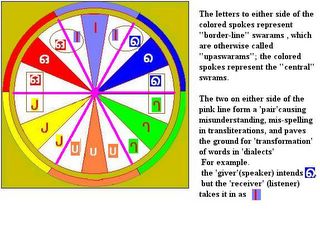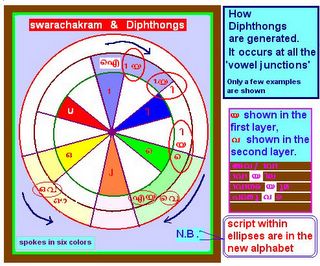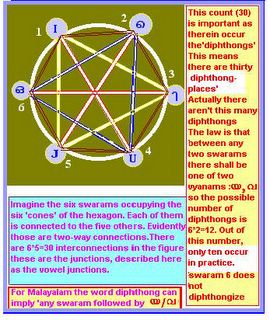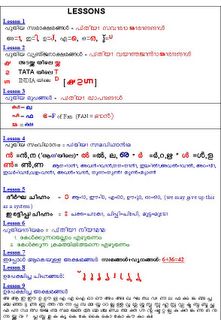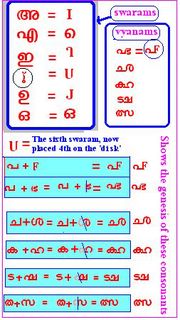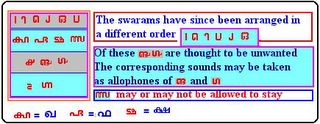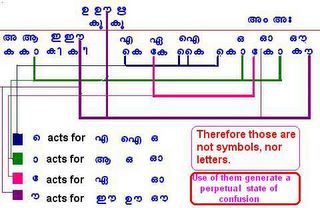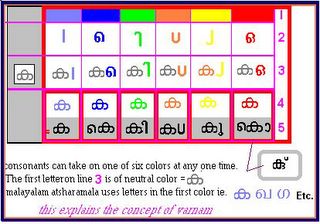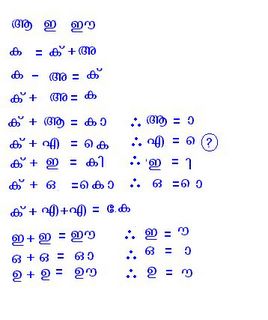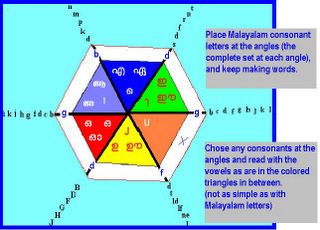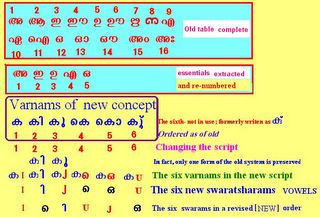Saturday, September 18, 2010
Tuesday, September 20, 2005
ALPHABETIC ORDER
Order is the most fundamental requirement for anything to be intelligible, basic in any intellectual activity or function. Alphabetic order is inevitable in any list of written material, the importance of which does not need explanation.
Now how well does it work in Malayalam?
We are well aware that there is no such thing as alphabetic order in Malayalam. Guess that this may be the reason for the unending chaos, or want of ordered progress in our social or political life. The reason for failure of early development of this ordering system in our language is naturally the unsuitability of out alphabet itself. This is painfully evident in our dictionaries: Often you are not very sure of ‘where’, that is, immediately after which letter you are to look for a particular word.
For example, can every one of us recall, in a fraction of a second, and open up a fast, the word t{] m »w, if that word is in a Malayalam dictionary?*********
The problem here is great because basically, as they say, ours is a syllabic system of writing- we write, sort of, syllables (also called atsharams) and their number is so vast we cannot get at them in a quick order. The total number of possible syllables is unmanageable when you intend to order them ‘alphabetically’. We do not have an alphabet in the true sense; that is what it means. All the same, we perfectly recognize the great importance of alphabetic ordering, so we resort to the English alphabet. This is happening ever since Malayalees learned English, and we are indebted.
How about it if we now have an alphabet, with 42 characters (letters) that behave like an alphabet? Try comparing the resulting situation with the now prevalent one.
ORDER AND RECALL
We have not studied much about the ‘recall mechanism’ of mind; at least, the average people do not have much knowledge about any such mechanism, even though they all have it functioning within them. We as ordinary persons can do with some inklings about it; some tips, perhaps.
Suppose we know to recite the English alphabet without any mistake, and we know the total number of letters in the alphabet is twenty-six. Now, look at three questions; they must all be answered the moment each one is read:
1. Which is the first letter of English alphabet?
2. Which is the nineteenth letter?
3. Which is the last letter?
[Assess for yourself, the success percentage]
Now answer another set of three questions:
1. Which is the letter before M?
2. Which is the letter after M?
3. Which are the letters before and after P?
The statistics of success in this test is likely to tell the greatest success rate. Why?
The mechanism of recall works like a torch flashed, focused on a point in the past. If it is a point on a list or a series or sequence, the torch does light up a point behind and a point ‘after’ the focal point. In other situations, the torch throws light on any one circle or another, of points around the focus; if not it shows up a sequence or series (starting) ahead from the focal point.
This discussion could be stretched to any length in order to establish that in Malayalam there is neither an ordered alphabet nor an alphabetic order!! However, there seems to be no such need for over-exertion.
WE ARE GOING TO ACHIEVE THESE WITH OUR MILLENNIUM ALPHABET!!!
Order is the most fundamental requirement for anything to be intelligible, basic in any intellectual activity or function. Alphabetic order is inevitable in any list of written material, the importance of which does not need explanation.
Now how well does it work in Malayalam?
We are well aware that there is no such thing as alphabetic order in Malayalam. Guess that this may be the reason for the unending chaos, or want of ordered progress in our social or political life. The reason for failure of early development of this ordering system in our language is naturally the unsuitability of out alphabet itself. This is painfully evident in our dictionaries: Often you are not very sure of ‘where’, that is, immediately after which letter you are to look for a particular word.
For example, can every one of us recall, in a fraction of a second, and open up a fast, the word t{] m »w, if that word is in a Malayalam dictionary?*********
The problem here is great because basically, as they say, ours is a syllabic system of writing- we write, sort of, syllables (also called atsharams) and their number is so vast we cannot get at them in a quick order. The total number of possible syllables is unmanageable when you intend to order them ‘alphabetically’. We do not have an alphabet in the true sense; that is what it means. All the same, we perfectly recognize the great importance of alphabetic ordering, so we resort to the English alphabet. This is happening ever since Malayalees learned English, and we are indebted.
How about it if we now have an alphabet, with 42 characters (letters) that behave like an alphabet? Try comparing the resulting situation with the now prevalent one.
ORDER AND RECALL
We have not studied much about the ‘recall mechanism’ of mind; at least, the average people do not have much knowledge about any such mechanism, even though they all have it functioning within them. We as ordinary persons can do with some inklings about it; some tips, perhaps.
Suppose we know to recite the English alphabet without any mistake, and we know the total number of letters in the alphabet is twenty-six. Now, look at three questions; they must all be answered the moment each one is read:
1. Which is the first letter of English alphabet?
2. Which is the nineteenth letter?
3. Which is the last letter?
[Assess for yourself, the success percentage]
Now answer another set of three questions:
1. Which is the letter before M?
2. Which is the letter after M?
3. Which are the letters before and after P?
The statistics of success in this test is likely to tell the greatest success rate. Why?
The mechanism of recall works like a torch flashed, focused on a point in the past. If it is a point on a list or a series or sequence, the torch does light up a point behind and a point ‘after’ the focal point. In other situations, the torch throws light on any one circle or another, of points around the focus; if not it shows up a sequence or series (starting) ahead from the focal point.
This discussion could be stretched to any length in order to establish that in Malayalam there is neither an ordered alphabet nor an alphabetic order!! However, there seems to be no such need for over-exertion.
WE ARE GOING TO ACHIEVE THESE WITH OUR MILLENNIUM ALPHABET!!!
Sunday, September 18, 2005
Thursday, September 15, 2005
Millennium Malayalam
Writing The Quasi Swarams
We did find that there are only six Swarams, whereas there were eighteen Swaratsharams in use. We have to handle the sounds represented by thirteen of the old letters.
The “long” swarams: Repeat the letter
The diphthongs: already explained
Others are written in a consonant and a swaram as are involved in the sound.
Shortcut To The Vyanjanamaala
One need not go through the tedious study of concerned articles before one starts using the vyanjanamaala.
Carefully study the pictures to recognize the new letters. Then move to the transcriptions.
Especially use the “Lessons”
Writing The Quasi Swarams
We did find that there are only six Swarams, whereas there were eighteen Swaratsharams in use. We have to handle the sounds represented by thirteen of the old letters.
The “long” swarams: Repeat the letter
The diphthongs: already explained
Others are written in a consonant and a swaram as are involved in the sound.
Shortcut To The Vyanjanamaala
One need not go through the tedious study of concerned articles before one starts using the vyanjanamaala.
Carefully study the pictures to recognize the new letters. Then move to the transcriptions.
Especially use the “Lessons”
Wednesday, September 14, 2005
Tuesday, August 30, 2005
Comments
Let me put in a few more words about S2 (swaram no.2); that would apply to S4, S6, S10 and S13, in exactly the same way. Imagine a boy, Tom, now about three feet tall; in course of time, he grows and attains the height of four feet,.. five feet etc.. During all this growth phase, does he become another person and then yet another person? He is Tom all the way, changes in height (length) or weight notwithstanding. A palm tree ten feet tall does not become another kind/species of tree as it attains twenty feet height.
The summary result, of the exercise carried out in full, is: out of the sixteen items, only five do qualify as swarams. Kindly go to file: “Exercising Swarams” (it is a big file)
The search for swarams does not end here. Some sound, called by a mysterious name ‘samvrutha ukaram’ is subjected to meticulous study. At the end, it is re-presented as the ‘sixth swaram’. Please study the document: “The Sixth Swaram”.
Thus, at last, we have six swarams in all; the Swaramaala is ready. In order to bring an item to a table, it must have its symbol - a letter, here- to represent it. We instantly created a letter, out of sheer necessity.
Next, we shall study the possibilities of ‘simplifying ‘ the vowel letters and ‘straightening the writing style’ according to the law of representation Go to article “Simplifying the Vowel Letters”
You must also; study the articles “The Invisible Swaram” and “the Negative Symbol” (the negative of a letter)
Let me put in a few more words about S2 (swaram no.2); that would apply to S4, S6, S10 and S13, in exactly the same way. Imagine a boy, Tom, now about three feet tall; in course of time, he grows and attains the height of four feet,.. five feet etc.. During all this growth phase, does he become another person and then yet another person? He is Tom all the way, changes in height (length) or weight notwithstanding. A palm tree ten feet tall does not become another kind/species of tree as it attains twenty feet height.
The summary result, of the exercise carried out in full, is: out of the sixteen items, only five do qualify as swarams. Kindly go to file: “Exercising Swarams” (it is a big file)
The search for swarams does not end here. Some sound, called by a mysterious name ‘samvrutha ukaram’ is subjected to meticulous study. At the end, it is re-presented as the ‘sixth swaram’. Please study the document: “The Sixth Swaram”.
Thus, at last, we have six swarams in all; the Swaramaala is ready. In order to bring an item to a table, it must have its symbol - a letter, here- to represent it. We instantly created a letter, out of sheer necessity.
Next, we shall study the possibilities of ‘simplifying ‘ the vowel letters and ‘straightening the writing style’ according to the law of representation Go to article “Simplifying the Vowel Letters”
You must also; study the articles “The Invisible Swaram” and “the Negative Symbol” (the negative of a letter)
Monday, August 29, 2005
ATSHARAMAALA
General Knowledge
Speech is the medium of communication, using human voice plus ‘oral sounds’ as the base substance. The base substance is available as simple discrete elements- the speech sounds- called phonemes(swanams in Malayalam)
Humans did not develop, to start with, a science of speech sounds; they simply started speaking. They could isolate and designate these elements only later on, even after having learned to transcribe sound into ‘visible’ symbols.
Of such symbols, those used in any one language, are collected and arranged in some permanent order; and that is the alphabet of that language, as we know. For the purpose of this study, we call the items of an alphabet as letters and hold that these letters represent elements of speech sound. (Though this assumption of course leads us into trouble at some places). In the case of Malayalam, alphabet is named atsharamala; the letters are atsharams, the phonemes vyanjanams (vyanams for short). (This is outbidding some silent debate in the minds of scientists, perhaps.)
Speaking about speech
Some difficulty in speaking about speech is natural. Early men spoke about things- real things, i.e. objects- but perhaps not about ideas. Their sound symbols carried these objects as “meaning”. It is a different case when we speak about speech, since we have to use ‘speech to speech about speech’. Note the error above? ‘The middle speech of the three speeches above’ acted as a verb by my intention; it should have been “to speak”, if the sentence was to be correct English. It is an example of how we re-shape words in order to carry different meanings. (To re-shape we cut a word in two, take one –the first- part as the root form and alter the other, or simply bring an add on to the root) This helps in ascribing different layers of meaning to a word (verbs and nouns), each time ‘disconnecting the word from a previous layer. Long ago in this process, our words lost touch with ‘their’ real meanings/objects, before we of now inherited the words from our ancestors.
Therefore, in speaking about speech we may have to keep track of every change of meaning of all words we use for a current project. This necessitates re-defining meaning of words in and for the current context. If, however, we stick fast to this as a rule we would hardly make progress; so the task of redefining is left to the reader most of the time leaving thereby some amount of difficulty in understanding the intended meaning. Misunderstanding is the inevitable result, just as inexactitude is the inevitable defect where you want to be exact.
Getting into action, we are to examine the atsharamala in detail. The two well recognized sections of the atsharamala are the swarams, and the vyanjanams.
The Swarams.
Swarams are defined as speech sounds, which can be uttered independently of other swarams or vyanjanams (the wording is mine, and may not be as good as a classical definition) .No definition is legally binding. Let us try to understand swarams, not the definition as given to us. No discussion is possible without real time reference to the subject matter- the swarams.
There is a problem in that we do not have names of swarams, which can e rendered in English letters. We overcome this by designating the letters with numbers, thus:
S1 for the first swaram on the Swaramaala (‘a’ in Manglish)
S2 for the second swaram on the Swaramaala (‘aa’ in Manglish)
S3 for the third swaram…
S4 for the fourth swaram…
…
S9 for the ninth swaram, which is sounded like ‘eru’ (as in Peru)
S15 The (swaram) item sounded like ‘am’, or ‘um’ as in sum (also called anuswaaram)
S16 The one sounded like ‘ah’ (also called visargham)
I have had serious doubt whether the definition justifies all the items on the swarams list. We therefore go for some refinements on the definition, taking three unquestionable, indubitable swarams- S1, S3 and S5- for a special study. Designate them as the ‘core group’.
Result:
1.Each of these swarams can be made audible as though they were pure elements. There is no admixture of any extraneous element. Say the sounds have purity
2.They have quantity and measurability they extend in time from a starting point to an endpoint. One average measure is called a ‘mathras’ (a meter of a special variety).
3.They can be prolonged in one utterance- to several mathras, that is. Call this ‘Malleability’ (or some other term)
4.They can climb, up or down, the musical scale (in one breath): Musicality
5.They can expand or shrink in volume: ‘elasticity’
These are intrinsic properties of the swarams of the core group. O. K.?
In addition, we postulate that each swaram must be unique: There shall be no two swarams, which sound ‘similar’. This is a condition warranted by the property (6) uniqueness
Now the rest of the work is to test the remaining items of the table to see if each of them posses all or any of these properties.
The revised definition of swaram would now be: “speech sounds, which can be uttered independently of other swarams or vyanjanams, and possessing the certain properties, namely…”
Item by item:
S1, S3 and S5 have proved that each of them possesses all these properties.
S2. This item is a repetition of S1 (!!), only two mathras long. There is no and unique swaram here, which is distinct from all the other items of the core group. Item no. 2, or S2, therefore, is not a swaram different from S1. Law [Dr.1] requires that S2 be removed from the table.
[Don’t you worry, we shall keep them in the “recycle bin[Dr.2] ” for the real recycling; in the meanwhile we let all copies of it to be in circulation as usual.]
S8. Here we may cut down this sound in three: (i) ‘e’ the ninth swaram (ii) the vyanjanam ‘r’ and (iii) the fifth swaram ‘u’. It therefore does not possess the property no.1. It starts as one swaram passes though a vyanjanam and ends in another swaram (u). Therefore, it cannot be quantified like other swarams. Try to prolong the sound: what gets prolonged is the last part of it namely the swaram ‘u’. Moreover, none of the other properties can be ascribed to this ‘item’. Item eight is therefore not a swaram.
Now for the rest of the exercise, I invite dear friends to try for themselves. The results may seem incredible. Yet inevitable they are. Please invite your near friends, too. (My own findings will be published soon)
[Dr.1]This law will be presented in a later section
[Dr.2]Those letters which we may have to delete do represent some sounds, which must be written. Alternatives we shall work out in due course
General Knowledge
Speech is the medium of communication, using human voice plus ‘oral sounds’ as the base substance. The base substance is available as simple discrete elements- the speech sounds- called phonemes(swanams in Malayalam)
Humans did not develop, to start with, a science of speech sounds; they simply started speaking. They could isolate and designate these elements only later on, even after having learned to transcribe sound into ‘visible’ symbols.
Of such symbols, those used in any one language, are collected and arranged in some permanent order; and that is the alphabet of that language, as we know. For the purpose of this study, we call the items of an alphabet as letters and hold that these letters represent elements of speech sound. (Though this assumption of course leads us into trouble at some places). In the case of Malayalam, alphabet is named atsharamala; the letters are atsharams, the phonemes vyanjanams (vyanams for short). (This is outbidding some silent debate in the minds of scientists, perhaps.)
Speaking about speech
Some difficulty in speaking about speech is natural. Early men spoke about things- real things, i.e. objects- but perhaps not about ideas. Their sound symbols carried these objects as “meaning”. It is a different case when we speak about speech, since we have to use ‘speech to speech about speech’. Note the error above? ‘The middle speech of the three speeches above’ acted as a verb by my intention; it should have been “to speak”, if the sentence was to be correct English. It is an example of how we re-shape words in order to carry different meanings. (To re-shape we cut a word in two, take one –the first- part as the root form and alter the other, or simply bring an add on to the root) This helps in ascribing different layers of meaning to a word (verbs and nouns), each time ‘disconnecting the word from a previous layer. Long ago in this process, our words lost touch with ‘their’ real meanings/objects, before we of now inherited the words from our ancestors.
Therefore, in speaking about speech we may have to keep track of every change of meaning of all words we use for a current project. This necessitates re-defining meaning of words in and for the current context. If, however, we stick fast to this as a rule we would hardly make progress; so the task of redefining is left to the reader most of the time leaving thereby some amount of difficulty in understanding the intended meaning. Misunderstanding is the inevitable result, just as inexactitude is the inevitable defect where you want to be exact.
Getting into action, we are to examine the atsharamala in detail. The two well recognized sections of the atsharamala are the swarams, and the vyanjanams.
The Swarams.
Swarams are defined as speech sounds, which can be uttered independently of other swarams or vyanjanams (the wording is mine, and may not be as good as a classical definition) .No definition is legally binding. Let us try to understand swarams, not the definition as given to us. No discussion is possible without real time reference to the subject matter- the swarams.
There is a problem in that we do not have names of swarams, which can e rendered in English letters. We overcome this by designating the letters with numbers, thus:
S1 for the first swaram on the Swaramaala (‘a’ in Manglish)
S2 for the second swaram on the Swaramaala (‘aa’ in Manglish)
S3 for the third swaram…
S4 for the fourth swaram…
…
S9 for the ninth swaram, which is sounded like ‘eru’ (as in Peru)
S15 The (swaram) item sounded like ‘am’, or ‘um’ as in sum (also called anuswaaram)
S16 The one sounded like ‘ah’ (also called visargham)
I have had serious doubt whether the definition justifies all the items on the swarams list. We therefore go for some refinements on the definition, taking three unquestionable, indubitable swarams- S1, S3 and S5- for a special study. Designate them as the ‘core group’.
Result:
1.Each of these swarams can be made audible as though they were pure elements. There is no admixture of any extraneous element. Say the sounds have purity
2.They have quantity and measurability they extend in time from a starting point to an endpoint. One average measure is called a ‘mathras’ (a meter of a special variety).
3.They can be prolonged in one utterance- to several mathras, that is. Call this ‘Malleability’ (or some other term)
4.They can climb, up or down, the musical scale (in one breath): Musicality
5.They can expand or shrink in volume: ‘elasticity’
These are intrinsic properties of the swarams of the core group. O. K.?
In addition, we postulate that each swaram must be unique: There shall be no two swarams, which sound ‘similar’. This is a condition warranted by the property (6) uniqueness
Now the rest of the work is to test the remaining items of the table to see if each of them posses all or any of these properties.
The revised definition of swaram would now be: “speech sounds, which can be uttered independently of other swarams or vyanjanams, and possessing the certain properties, namely…”
Item by item:
S1, S3 and S5 have proved that each of them possesses all these properties.
S2. This item is a repetition of S1 (!!), only two mathras long. There is no and unique swaram here, which is distinct from all the other items of the core group. Item no. 2, or S2, therefore, is not a swaram different from S1. Law [Dr.1] requires that S2 be removed from the table.
[Don’t you worry, we shall keep them in the “recycle bin[Dr.2] ” for the real recycling; in the meanwhile we let all copies of it to be in circulation as usual.]
S8. Here we may cut down this sound in three: (i) ‘e’ the ninth swaram (ii) the vyanjanam ‘r’ and (iii) the fifth swaram ‘u’. It therefore does not possess the property no.1. It starts as one swaram passes though a vyanjanam and ends in another swaram (u). Therefore, it cannot be quantified like other swarams. Try to prolong the sound: what gets prolonged is the last part of it namely the swaram ‘u’. Moreover, none of the other properties can be ascribed to this ‘item’. Item eight is therefore not a swaram.
Now for the rest of the exercise, I invite dear friends to try for themselves. The results may seem incredible. Yet inevitable they are. Please invite your near friends, too. (My own findings will be published soon)
[Dr.1]This law will be presented in a later section
[Dr.2]Those letters which we may have to delete do represent some sounds, which must be written. Alternatives we shall work out in due course
